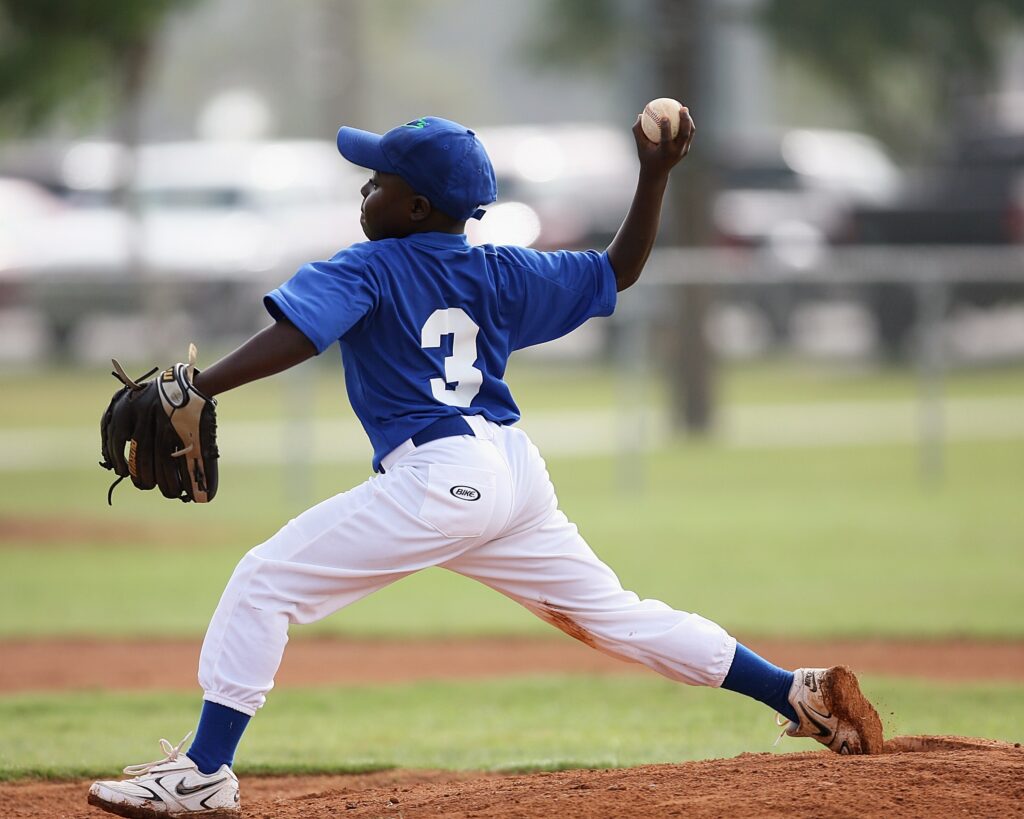How Do Shoulder-Throwing Injuries Occur?
Whether you’re a professional competitor or playing in the Little Leagues, in throwing athletes, stress on the shoulder is a major concern. Many youth sports activities challenge the stability of the shoulders through repetitive overhand activity. While overuse injuries are most common in baseball and softball, swimmers, gymnasts, tennis, volleyball and cricket players can also develop symptoms. Overhand throwing places extremely high stresses on the shoulders of young athletes, particularly to the ligaments that keep the shoulder stable in the socket. In throwing athletes, these high-stress movements are repeated many times and may lead to a range of shoulder-throwing injuries. Because adolescence is generally a period of rapid growth, teen athletics can present a particular challenge to immature bones and developing soft tissues when injured.
During an overhand pitch or throw, an athlete’s arm moves through several extreme positions that put the upper arm under a great deal of pressure. Over time, the repeated stress of throwing can cause the growth plate at the top of the upper arm to become injured and inflamed.
Shoulder-throwing injuries in child and teen athletes can include:
- SLAP Tears (Superior Labrum Anterior and Posterior) – an injury to the labrum of the shoulder, the ring of cartilage that surrounds the socket of the shoulder joint. This can happen when you tear cartilage in the inner part of your shoulder joint. The tears can be caused by injury or overuse and make it painful or difficult to move your shoulder and arm. Although rare in comparison to adults, SLAP tears do occur in children and adolescents.
- Bicep Tendonitis – repetitive throwing can inflame and irritate the upper biceps tendon resulting in bicep tendonitis. Pain in the front of the shoulder and weakness are common symptoms. Occasionally, the damage to the tendon caused by tendonitis can result in a tear. In children, the tendon itself is very strong and not as vulnerable to injury as in adults; however, older children who participate in sports can experience this injury.
- Internal Impingement – a cause of shoulder pain in overhead athletes caused by a pinching of the labrum or rotator cuff in the back of the shoulder. Internal impingement is less likely to occur in children than adults, but it can still happen, particularly in adolescent athletes who overwork their shoulders.
- Instability of the Shoulder – occurs when the head of the upper arm bone is forced either partially or completely out of the shoulder socket.
- Scapular Dysfunction – refers to the abnormal mobility or function of the scapula (shoulder blade), causing weakness in the arm or a feeling of heaviness, pain or tenderness on and around the shoulder blade.
How To Tell If Your Child Has A Shoulder-Throwing Injury
Pain due to inflammation or irritation is the primary symptom associated with shoulder-throwing injuries in child and teen athletes, often progressing to pain during normal daily activities. Occasionally a player may feel as if their shoulder feels loose or is coming out of the socket, but most often the problem is pain during or after throwing. With shoulder-throwing injuries, there is often no visible swelling, but the young athlete may experience a dull ache, some loss of motion in the shoulder, or in some cases, an increased motion may be present. Early symptoms include pain that radiates from the front of the shoulder to the side of the arm. As the problem progresses, pain may occur at night, and the athlete may experience a loss of strength and motion.
How To Diagnose Shoulder-Throwing Injuries
Shoulder-throwing injuries are diagnosed by an athlete’s history, pain related to the sport and by a physical examination. However, determining the exact cause of shoulder pain in the child throwing athlete can be difficult. Given that the shoulder has a certain amount of mobility that is normal, a physical examination is not always a clear indication as to whether the shoulder is loose. Additionally, labrum tears do not produce a characteristic set of signs or pain that distinguish them from tendonitis pain. Shoulder X-rays can be used to evaluate the shoulder anatomy and if there is any involvement of the growth plate. An MRI is an excellent choice for examining the shoulder joint. An MRI gives clear views of rotator cuff tears, injuries to the biceps tendon and damage to the glenoid labrum, the soft fibrous tissue rim that helps stabilize the joint.
How To Treat Shoulder-Throwing Injuries
Most shoulder-throwing injuries are best treated by a temporary avoidance of the throwing motion. Using ice as a shoulder injury treatment after throwing or throughout the day is a good place to start, accompanied by anti-inflammatory medications to diminish pain and swelling. If you or your child recognizes something is wrong, and there may be an overuse injury, don’t delay when it comes to seeing a pediatric orthopedist. Upon evaluation, the specialist may suggest physical therapy sessions to help increase strength and work to stretch tight musculature, diminishing the risk of recurrence upon return to throwing. Physical therapy professionals can also evaluate a young patient’s throwing mechanics, assess the proper form and make recommendations to improve the range of motion in a child or teen’s shoulder and ways to strengthen the muscles that support the joints. Occasionally, surgery may be needed to repair a torn labrum or rotator cuff or to improve shoulder stability.
How Can We Help?
The Pediatric Orthopedic Center is an award-winning practice with offices in Cedar Knolls, Springfield and Wayne. For more information on how we can assist with any shoulder-throwing injury concerns that you may have, please visit our website to book a consultation!



